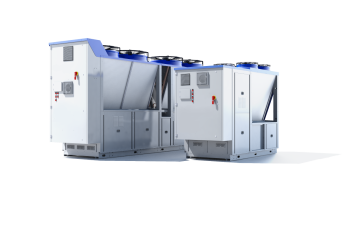Natural selection: The rise of low GWP refrigerants
Natural refrigerants formed the basis for the first refrigeration systems. However, as technology evolved, they were replaced by man-made refrigerants. These synthetic refrigerants were engineered with properties to suit different HVAC and refrigeration applications, and to overcome issues such as flammability, toxicity and corrosion. Synthetic refrigerants include Chlorofluorocarbons (CFCs), Hydrochlorofluorocarbons (HCFCs), Hydrofluorocarbons (HFCs) and Hydrofluoroolefins (HFOs).
However, it was discovered that the benefits of synthetic refrigerants came at a cost. CFCs and HCFCs had a high Ozone Depletion Potential (ODP), causing grave harm to the ozone layer. While their replacement, HFCs, had a high Global Warming Potential (GWP) contributing to global warming and climate change.
Under the Montreal Protocol, (and several subsequent amendments), a number of countries agreed to the gradual phase out of CFCs and HCFCs, and the phase down of HFCs. In an act of survival of the fittest, we are going full-circle back to natural refrigerants. Natural refrigerants such as Carbon Dioxide (CO2), Propane (C3H8), Ammonia (NH3) and Brine have either no, or extremely low GWP and ODP, offering options for proven, future-proof, environmentally friendly refrigerants.
F-Gas Regulations, the Montreal Protocol and the HFC phase down
Under the Montreal Protocol, CFCs were the first to be banned in developed countries by 2000 and developing countries by 2010. Next were HCFC’s, with a phase out in developed countries by 2020 and by 2030 in the developing world.
The fate of HFCs was sealed by the Kigali Amendment to the Montreal Protocol in October 2016. Under the Montreal Protocol, developed countries committed to a gradual HFC phase down from 2019. In developing countries a freeze on HFC consumption levels comes into force from 2024 (or 2028 for some nations), with the aim for a 80-85% reduction in HFCs by the late 2040s.
However, some regions such as the European Union (EU), are aiming for a faster and more comprehensive HFC phase down to help to reach ambitious decarbonisation targets. As a fluorinated gas, HFCs are bound by the EU’s F-Gas Regulations. The current regulations aim to cut fluorinated gas emissions by two-thirds by 2030 compared to 2014 levels. The Regulations are taking a phased approach, starting with the most environmentally harmful according to GWP. Different product types also abide by different GWP limits. For example, heat pump systems containing less than 3kg of refrigerant, can use fluids with a GWP of up to 750 until they are banned in 2025, while in the refrigeration sector, heat exchangers for instance can use refrigerants with GWP up to 1500 until they are also banned in 2025. The aim is to drive out high GWP refrigerants and replace them with low GWP natural refrigerants, Hydrofluoroolefins (HFOs) and refrigerant blends.
As an example, the following is the HFC roadmap for the refrigeration sector:
2020: All refrigerants with GWP over 2500 are banned. Examples include:
| Refrigerant | GWP |
|---|---|
| R-404A | 3922 |
| R-507A | 3985 |
| R-422A | 4143 |
| R-422D | 2729 |
2022- 2025: All refrigerants with GWP over 1500 are banned. Examples include:
| Refrigerant | GWP |
|---|---|
| R-407A | 2107 |
| R-407F | 1825 |
| R-407C | 1774 |
| R-410A | 2088 |
| R-452A | 2141 |
2030: All refrigerants with GWP over 150 are banned. Examples include:
| Refrigerant | GWP |
|---|---|
| R-32 | 675 |
| R-134a | 1430 |
| R-448A | 1273 |
| R-449A | 1397 |
| R-450A | 600 |
| R-513A | 631 |
As the number of synthetic refrigerants available to use legally shrinks, prices rise and refrigerant shortages bite, natural refrigerants will rise in prominence.
Natural refrigerants: The sustainable solution
Natural refrigerants have a proven track record, going back to the first refrigeration systems. The obstacles that may have made their use prohibitive in the past (flammability, toxicity or corrosion) are rapidly being overcome by modern technology, materials and health and safety practices. This means that natural refrigerants such as carbon dioxide, propane, ammonia and Brine are suitable for use in a growing range of applications and are increasing in popularity.
Carbon dioxide (CO2 / R-744)
R-744 makes an excellent replacement for HFCs due to its non-flammable and non-explosive qualities, along with its low environmental impact (GWP=1 and OPD=0). CO2 has several other advantages such as a low mass volume, which allows for the installation of compact equipment and its use in small quantities. It also has a low compression ratio, is available in the environment, and is compatible with all materials as it is non-corrosive. CO2 is idea for use in a range of applications including heat exchangers, condensing units and refrigerated display cabinets.
Propane (C3H8 / R-290)
R-290 has a low environmental impact (WGP=3 and ODP=0) and is non-toxic. Compared to HCFCs and HFCs propane has a lower system pressure drop and higher heat transfer performance, it also has lower density, resulting in a lower refrigerant charge. It has excellent thermodynamic performance, as it can go from a very low evaporating temperature to a high condensing temperature. It also has good compatibility with materials. Unlike Hydrofluoroolefins (HFOs), it doesn’t break down into trifluoroacetic acid (TFA) or any harmful substance. However, propane is highly flammable, resulting in additional health and safety rules and restrictions. Propane is suited as a refrigerant in a range of applications including heat pumps and chillers.
Ammonia (NH3 / R-717)
R-717 is a highly efficient refrigerant with no environmental impact (WGP=0 and ODP=0). Like propane it has an excellent thermodynamic performance, as it can go from a very low evaporating temperature to a high condensing temperature and it has excellent heat transfer properties. However, Ammonia is toxic and flammable at certain concentrations, resulting in additional health and safety rules and restrictions. Ammonia is not compatible with some materials (e.g. copper). Due to issues with toxicity and its high efficiency, Ammonia is primarily used in industrial refrigeration applications, with high capacity charges.
Brine
Brine is a mixture of salt and water (a salt solution), typically a mix of either sodium chloride (NaCl), calcium chloride (CaCl2) or potassium chloride (KCl) with water. The addition of salt to water increases heat transport efficiency and lowers the freezing point. Brine is environmentally friendly (GWP=0), non-toxic and non-flammable. However, brine is corrosive. Brine is primarily used as a secondary refrigerant and in low temperature chiller applications or heat exchangers.
Certification of natural refrigerants
As HVAC and refrigeration manufacturers switch to natural refrigerants, certifying bodies have to adapt their certification programmes. Eurovent Certita Certification uses European Standards as a baseline for its certification schemes, therefore changes to F-Gas Regulations affect a large proportion of certified products.
While natural refrigerants such as CO2 are already certified under a number of Eurovent programmes, the list is likely to grow. Additionally, there is an increasingly urgent need to add new natural fluids such as propane, ammonia and Brine to various programmes as an alternative to high GWP HFCs. Likewise low GWP Hydrofluoroolefins (HFOs) and refrigerant blends need to be considered, as natural refrigerants may not be the fluid of choice for all applications.
The industry can rest assured that Eurovent Certita Certification has been working on the introduction of new refrigerants for some years. However, it’s not a quick or easy process to add new refrigerants into the testing and evaluation process. This especially true of fluids such as ammonia, where special measures are needed due to toxicity and flammability.
It is a huge job to adapt all relevant certification programmes, and of course adding new fluids is not the only consideration. Eurovent Certita Certification has to also ensure that banned refrigerants are no longer declared nor certified, while navigating the minefield of regulatory change.
Conclusion
The writing has been on the wall for HFC refrigerants since the 2015 F-Gas Regulations came into force. Natural refrigerants have either no, or extremely low GWP and ODP, offering future-proof, environmentally friendly refrigerants with a proven track record. The issues that gave rise to synthetic refrigerants - flammability, toxicity or corrosion - are being overcome, as manufactures find solutions to the issues of the past. The availability and cost of natural refrigerants will also help to expand their reach in the refrigerant market.
Manufacturers, specifiers, designers, installers, facilities mangers and end users alike will all be affected by refrigerant changes, as will Eurovent certification schemes. While natural refrigerants such as C02, propane, ammonia and Brine, may not be the answer for every HVAC or refrigeration application, it is evident they will dominate the market going forward.
Looking for energy efficient and low GWP products? Use our certified product directory to search for thousands of HVAC and refrigeration products online.
Search our certified product directory





